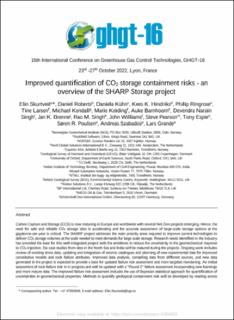| dc.contributor.author | Skurtveit, Elin | |
| dc.contributor.author | Roberts, Daniel | |
| dc.contributor.author | Kühn, Daniela | |
| dc.contributor.author | Hindriks, Kees K. | |
| dc.contributor.author | Ringrose, Philip | |
| dc.contributor.author | Larsen, Tine | |
| dc.contributor.author | Kendall, Michael | |
| dc.contributor.author | Keiding, Marie | |
| dc.contributor.author | Barnhoorn, Auke | |
| dc.contributor.author | Singh, Devendra Narain | |
| dc.contributor.author | Brenne, Jan Kristoffer | |
| dc.contributor.author | Singh, Rao Martand | |
| dc.contributor.author | Williams, John | |
| dc.contributor.author | Pearson, Steve | |
| dc.contributor.author | Espie, Tony | |
| dc.contributor.author | Poulsen, Søren R. | |
| dc.contributor.author | Szabados, Andreas | |
| dc.contributor.author | Grande, Lars | |
| dc.date.accessioned | 2023-03-31T10:50:15Z | |
| dc.date.available | 2023-03-31T10:50:15Z | |
| dc.date.created | 2022-12-19T15:09:03Z | |
| dc.date.issued | 2022 | |
| dc.identifier.uri | https://hdl.handle.net/11250/3061392 | |
| dc.description.abstract | Carbon Capture and Storage (CCS) is now maturing in Europe and worldwide with several Net Zero projects emerging. Hence, the need for safe and reliable CO2 storage sites is accelerating and the accurate assessment of large-scale storage options at the gigatonne-per-year is critical. The SHARP project addresses the main priority areas required to improve current technologies to deliver CO2 storage volumes at the scale needed to meet demands for large scale storage. Research needs identified in the industry has provided the base for this well-integrated project with the ambitions to reduce the uncertainty in the geomechanical response to CO2 injection. Six case studies from sites in the North Sea and India will be matured during the projects. Ongoing work includes review of existing stress data, updating and integration of seismic catalogues and planning of new experimental data for improved constitutive models and rock failure attributes. Improved data analysis, compiling data from different sources, and new data generated in the project is expected to provide a base for updated failure risk assessment and more targeted monitoring. An initial assessment of rock failure risk in in progress and will be updated with a "Round 2" failure assessment incorporating new learnings and more mature data. The improved failure risk assessment includes the use of Bayesian statistical approach for quantification of uncertainties in geomechanical properties. Methods to quantify geological containment risk will be developed by reading across event tree techniques from other industries (e.g. nuclear). A set of generic release diagrams have been derived in a series of interdisciplinary workshops as a starting point for risk modelling | |
| dc.description.abstract | Improved quantification of CO2 storage containment risks - an overview of the SHARP Storage project | |
| dc.language.iso | eng | |
| dc.title | Improved quantification of CO2 storage containment risks - an overview of the SHARP Storage project | |
| dc.title.alternative | Improved quantification of CO2 storage containment risks - an overview of the SHARP Storage project | |
| dc.type | Journal article | |
| dc.description.version | publishedVersion | |
| dc.source.journal | 16th Greenhouse Gas Control Technologies Conference 2022 (GHGT-16) | |
| dc.identifier.cristin | 2095314 | |
| dc.relation.project | EC/H2020/327342 | |
| cristin.ispublished | true | |
| cristin.fulltext | original | |
